3 Chapter 3: From Bronze to Iron or the International Age
Last we left Mesopotamia, civilization was around 1,000 years old and had taken the form of multiple city-states ruled by warrior kings. However, by approximately 2300 BCE, the city-states had to worry about competition and conflict with many more peoples than one another. Specifically they faced competition from the surrounding peoples of the larger desert who coveted Mesopotamia’s wealth, specifically the growing wealth in metals and luxury goods (improved tools, weapons, etc. made from bronze instead of the much softer copper). Some conquerors came from this hinterland, including the Akkadians.
The Bronze Age is a term used to describe a period in the ancient world from about 3000 BCE to 1100 BCE. That period saw the emergence and evolution of increasingly sophisticated ancient states, some of which evolved into the first real empires. It was a period in which long-distance trade networks and diplomatic exchanges between states became permanent aspects of political, economic, and cultural life in the eastern Mediterranean region. It was, in short, the period during which civilization itself spread and prospered across the area, or the first International Age.
The period is named after one of its key technological bases: the crafting of bronze. Bronze is an alloy of tin and copper. An alloy is a combination of metals created when the metals bond at the molecular level to create a new material entirely. Needless to say, historical peoples had no idea why, when they took tin and copper, heated them up, and beat them together on an anvil they created something much harder and more durable than either of their starting metals. Some innovative smith did figure it out, and in the process ushered in an array of new possibilities.
Bronze was important because it revolutionized warfare and, to a lesser extent, agriculture. The harder the metal, the deadlier the weapons created from it and the more effective the tools. Agriculturally, bronze plows allowed greater crop yields. Militarily, bronze weapons completely shifted the balance of power in warfare; an army equipped with bronze spears, arrowheads, and bronze armor was much more effective than one wielding wooden, copper, or obsidian implements.
An example of bronze’s impact is, as noted in the previous chapter, the expansionism of the Egyptian New Kingdom. The New Kingdom of Egypt conquered more territory than any earlier Egyptian empire. The Egyptians were able to do this in part because of their mastery of bronze-making and the effectiveness of its armies as a result. The New Kingdom also demonstrates another noteworthy aspect of bronze: it was expensive to make and expensive to distribute to soldiers, meaning that only the larger and richer empires could afford it on a large scale. Bronze tended to stack the odds in conflicts against smaller city-states and kingdoms, because it was harder for them to afford to field whole armies outfitted with bronze weapons. Ultimately, the power of bronze contributed to the creation of a whole series of powerful empires in North Africa and the Middle East, all of which were linked together by diplomacy, trade, and (at times) war.
The Bronze Age States
There were four major regions along the shores of, or near to, the eastern Mediterranean that hosted the major states of the Bronze Age: Greece, Anatolia, Canaan and Mesopotamia, and Egypt. Those regions were close enough to one another (e.g. it is roughly 800 miles from Greece to Mesopotamia, the furthest distance between any of the regions) that ongoing long-distance trade was possible. While wars were relatively frequent, most interactions between the states and cultures of the time were peaceful, revolving around trade and diplomacy. Each state, large and small, oversaw diplomatic exchanges written in Akkadian (the international language of the time) maintaining relations, offering gifts, and demanding concessions as circumstances dictated. Although the details are often difficult to establish, we can assume that at least some immigration occurred as well.
Ancient Babylon
By 2200 BCE the Akkadian empire broke up into a series of smaller successor states as a result of Civil War. These smaller states would eventually become the Babylonians and the Syrians. But first, the Sumerians actually reclaimed glory in the 3rd Dynasty of Ur (2112-2004 BCE), during which they called themselves the “kings of Sumer and Akkad.” This demonstrates that the Akkadian Empire was not erased from Sumer’s history like that of the Hyksos in Egypt. Instead the use of this title, which continued to be used for the next 1500 years, recognized the existence of a composite, common Mesopotamian culture/society. Nevertheless, Mesopotamia remained politically unstable and the Ur Kings could not protect their people and dynasty from internal and external rivals. Again Civil War ripped apart the Sumerians, this time with attacks from Amorite marauders.
Turmoil dating from 2000 BCE ushered in new Kingdoms, among them the Amorite Kingdom (otherwise known at the Babylonians, another Semitic people) in about 1900 BCE. The capital of the Amorites was Babylon. Perhaps one of the most important things to emerge from Babylonian society and culture is Hammurabi’s Code (a legal code) written by King Hammurabi who ruled Babylon about 600 years after Sargon. Much of his 42 year reign was devoted to creating a Mesopotamian empire. He was a careful administrator who ushered in an era of prosperity and cultural flowering. But he is most famous for the law code. Upon a careful reading of the code, one quickly sees that it is less of an actual code and more of a collection listing various crimes and punishments, likely fairly recent offenses and punishments. On the other hand Hammurabi’s Code is a kind of treatise on justice meant to glorify Hammurabi as an arbiter of justice, as a judge divinely appointed. In the opening of the code, Hammurabi states his goal for the law code is/was to support “the principles of truth and equity” for all. Upon close examination of the code, this goal appears less sincere.
In any case, Hammurabi’s Code has become both a legal and literary classic as it paints a remarkable portrait of Mesopotamian society. The document contains nearly 300 rulings in court cases ranging from family to commercial law, from wage rates to murder. The administration of justice in Mesopotamia was entirely practical: one finds no notion of abstract absolutes or universal principles, not even a word for “law.” Though actually less harsh then earlier law codes, the first one dating from 2100 BCE that prescribed death for nearly all crimes, Hammurabi’s code is by no means lenient. Whereas other earlier codes were often satisfied with payment in silver as recompense for crimes, Hammurabi’s Code was the first to stipulate such ruthless penalties as mutilations, drowning, and impaling. It also introduced the laws of retaliation for wounds: “If a man has destroyed the eye of a member of the aristocracy they shall destroy his eye. If he has broken his limb: they shall break the same limb.” Moreover, children could be punished for the crimes of their fathers. The code, published approximately in 1750 BCE, was inscribed in 49 vertical columns on a stone stele about 7.5 feet high and displayed in a prominent public place, symbolizing the notion that the law belongs to and governs over everyone.
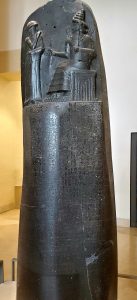
Despite the published idea of laws applying to everyone, Babylonian society was not egalitarian and the laws illustrate this clearly. Punishments were in most cases class-based; crimes against a free person received higher punishments than against a slave or semi-free person. Debt was another very important issue, with failure to pay said debt frequently leading to slavery. Though women could own land and testify in court, the code was patriarchal, as Babylonian society was turning more and more in that direction. The code enshrined the male as the head of the family. For example, a son who struck his father had his hand cut off, while a woman who brought about the death of her husband “because of another man” was impaled on stakes.
The Hittites
One state whose very existence coincided with the Bronze Age, vanishing afterwards, was that of the Hittites. Beginning in approximately 1700 BCE, the Hittites established a large empire in Anatolia, the landmass that comprises present-day Turkey. The Hittite Empire expanded rapidly based on a flourishing bronze-age economy, expanding from Anatolia to conquer territory in Mesopotamia, Syria, and Canaan, ultimately clashing with the New Kingdom of Egypt. The Hittites fought themselves to a stalemate against the Egyptians, after which they reached a diplomatic accord to hold on to Syria while the Egyptians held Canaan.
Unlike the Egyptians, the Hittites had the practice of adopting the customs, technologies, and religions of the people they conquered and the people they came in contact with. They did not seek to impose their own customs on others, instead gathering the literature, stories, and beliefs of their subjects. Their pantheon of gods grew every time they conquered a new city-state or tribe, and they translated various tales and legends into their own language. There is some evidence that it was the Hittites who formed the crucial link between the civilizations of Mesopotamia and the civilizations of the Mediterranean, most importantly of the Greeks. The Hittites transmitted Mesopotamian technologies (including math, astronomy, and engineering) as well as Mesopotamian legends like the Epic of Gilgamesh, the latter of which may have gone through a long process of translation and re-interpretation to become the Greek story of Hercules. Simply put, the Hittites were the quintessential Bronze Age civilization: militarily powerful, economically prosperous, and connected through diplomacy, trade, and war with the other cultures and states of the time.
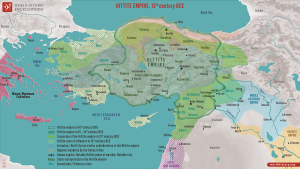
While quintessentially of the Bronze Age, the Hittites were still unique for a few reasons. First and foremost, they were the first civilization who spoke an Indo-European language. Almost all the peoples discussed up to now spoke a language belonging to the large Afro-Asiatic language family. But none of these languages survived antiquity in Europe. Instead, virtually every modern European language- as well as the dominant languages of Iran and India- are descendants of the long-lost proto-Indo-European language. These languages from English and Russian to Iranian and Hindi are said to belong to the Indo-European language family.
Indo-European speakers probably originated between 4500 and 2500 BCE in southern Russia, the Caucasus area between the Black and Caspian Seas. They were warlike and mobile, migrating to western Asia (where they became the Hittites) and finally to Anatolia around 1800 BCE. There the Hittites worked to control the trade travelling through their territory, expanding and growing their army as a result. The Hittites were absolute masters of the horse, which they harnessed to chariots in battle, like the Hyksos before them.
Excavated Hittite tablets show that the chariot’s main use was as a weapon of surprise, of moving battles. The chariot was most effective while in motion, driving through enemy infantry. Thus, paired crews of driver and warrior were most common. The driver would be unarmed, while the warrior would be wearing heavy armor and sporting a bow, spear, or sword. Chariots would be at the center of the battlefield when the Hittites and Egyptians came to blows towards the end of the “International System” discussed below.
Competition between the Egyptians and Hittites eventually came to a climax in the Battle of Qadesh in northern Syria pitting Ramses II against the Hittites. The Egyptians could stand no further expansion southward on the part of the Hittites. At Qadesh in 1274 BCE 20,000 Egyptian troops faced 17,000 Hittite soldiers. They were literally evenly matched, so the battle basically ended in a stalemate, although King Ramses II claimed a victory publicly. However, the treaty shows that it was actually a stalemate or loss for the Egyptians. What is most amazing is that the treaty survived, and it stands as one of the first written treaties scripted to end a war ever documented. In it both the kings of the Egyptians and Hittites promised to be brothers forever, and indeed the Hittite King did give his daughter to Ramses II in marriage 13 years later. But the peace did not last for long. And when the empires again came to blows it was within the context of the much larger devastations of 1200-1000 BCE.
The First International/Mediterranean System
To the east of the Hittite Empire, Mesopotamia was not ruled by a single state or empire during most of the Bronze Age. The Babylonian empire founded by Hammurabi was overthrown by the Kassites (whose origins are unknown) in 1595 BCE .This conquest was followed by a Hittite invasion that sacked Babylon but did not stay to control it. Over the following centuries, the Kassites successfully ruled over Babylon and the surrounding territories, with the entire region enjoying a period of prosperity. To the north, beyond Mesopotamia (the land between the rivers) itself, a rival state known as Assyria both traded with and warred against Kassite-controlled Babylon. Eventually (starting in 1225 BCE), Assyria led a short-lived period of conquest that conquered Babylon and the Kassites, going on to rule over a united Mesopotamia before being forced to retreat against the backdrop of a wider collapse of the political and commercial network of the Bronze Age (described below). More on the Assyrians to come.
The Minoans
To the west, it was during the Bronze Age that the first distinctly Greek civilizations arose: the Minoans of the island of Crete and the Mycenaeans of Greece itself. Their civilizations, which likely merged together due to invasion after a long period of coexistence, were the basis of later Greek civilization and thus a profound influence on many of the neighboring civilizations of the Middle East in the centuries to come, just as the civilizations of the Middle East unquestionably influenced them. At the time, however, the Minoans and Mycenaeans were primarily traders and, in the case of the Mycenaeans, raiders, rather than representing states on par with those of the Hittites, Assyrians, or Egyptians.
The name Minoan comes from the archaeologist, Arthur Evans, who discovered some of the first ruins of Minoan society when he was searching the island of Crete for traces of the mythic king Minos in the 1940s. Supposedly King Minos built the first great navy and kept a half-human/half-bull or Minotaur in a labyrinth near his palace. In Greek mythology, Minos was a king of Crete, son of Zeus and Europa. Every nine years, he made King Aegeus pick seven young boys and seven young girls to be sent to the labyrinth, to be eaten by the Minotaur. After his death, Minos became a judge of the dead in the underworld.
Evans believed that he discovered Minos’s palace (or perhaps the rulers residence on which the myth was based) in the palace site of Knossos, also the possible capital of the Minoan society. This was one of many palace sites, though one of the largest, which helped to identify the Minoan/Crete society as a Palace society. This categorization recognizes the social organization of the island, in which rulers built large palace complexes, each ruled fairly independently, with a population clustered around each palace. The palace complexes combined government, spiritual, and commercial centers in huge, sprawling areas of buildings that were interconnected and which housed thousands of people. Inside the palace complexes the ruler, their families, and their servants lived while also administering to the economic, political, and religious needs of the very small states that they governed. In many ways these were similar to Sumerian city-states, but with the unique palace center. Additionally, we must not assume the complexes to have been small, Knossos for example had hundreds of rooms. While the centers of civilization may have been confined to one or two complexes, the actual palaces were enormous and capable of housing thousands of individuals.
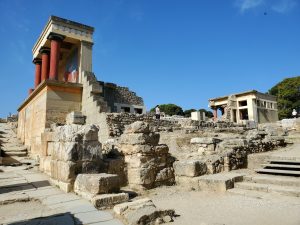
In one such room within the Knossos palace lies the now famous wall painting of the Bull-Leaper. This depicts a young man very acrobatically somersaulting/tumbling/leaping over a charging bull. This painting, and others like it have led some scholars to speculate that the Minoans incorporated bull worshipping into their religion and that this might actually depict a real ceremony.
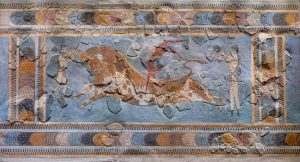
In addition to the prevalence of art featuring bulls, another interesting characteristic of Knossos and other palace settlements was their lack of defensive walls. This has led some to believe that the Minoans were able to live in peace with one another, almost competition free. But, conflict and competition were present as is evidenced by burials including weapons. There is also evidence of a largescale Minoan navy. The Minoans were excellent seafarers. Whereas almost all of the other civilizations of the eastern Mediterranean were land empires, albeit ones who traded and traveled via waterways, the Greek civilizations were very closely tied to the sea itself. Perhaps, then, as a naval power the Minoans simply focused more on offense and less on defense, relying on their island location for protection. Either way the Minoans were not an isolated society but traded and interacted regularly with both the Egyptians and the Hittites. Minoan frescoes have even been found in the ruins of an Egyptian (New Kingdom) palace, indicating that Minoan art was valued outside of Crete itself.
The Minoans developed their own systems of bureaucracy and writing. They used a form of writing referred to by historians as Linear A that has never been deciphered. It is clear that the text is a pre-cursor for Mycenean Linear B and eventually Greek script. However, it is still largely unintelligible. What historians do know is that the few documents they have been able to interpret are official and economically focused. Nothing resembling literature or poetry has survived or been discovered. The dearth of cultural scripts is more surprising because the Minoans seem to have had a vibrant culture, producing vivid paintings, lamps, clothes, and pottery for both practical use and decoration. This labor specialization was possible due to the Minoan discovery of Mediterranean polyculture or the cultivation of olives, grapes, and grains, in a single interrelated agricultural system.
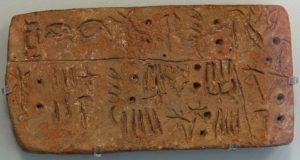
The Minoan civilization was very rich and powerful by about 1700 BCE and it continued to prosper for centuries. Starting in the early 1400s BCE, however, a wave of invasions carried out by the Mycenaeans to the north eventually extinguished Minoan independence. By that time, the Minoans had already shared artistic techniques, trade, and their writing system with the Mycenaeans, the latter of which served as the basis of Mycenaean record keeping in a form referred to as Linear B. Thus, while the Minoans lost their political independence, Bronze-Age Greek culture as a whole became a blend of Minoan and Mycenaean influences.
The Mycenaeans
The Mycenaeans arrived in the Greek Peninsula circa 1800 BC, and invaded and conquered the Minoans a few hundred years later. All the palace complexes on Crete were destroyed around 1550, except Knossos, suggesting some sort of violent conquest of the island by the Mycenaeans. Unlike the Minoans, we do know that the Mycenaeans were the earliest speakers of Greek. They were also vibrant traders, adopting technology, ideas, and art from Anatolia, Egypt, and Syria-Palestine. From Sicily to the Levant, they exported wine and scented oils and imported metals, ivory and perhaps slaves. They were also a warrior society, with warrior kings who fought their neighbors usually in an effort to collect booty. So the Mycenaeans were more like the Sumerian city states, both sharing a common culture and language, but also vying for resources, wealth, and power often violently.
The Mycenaeans displayed their wealth in the same style as had the Minoans, re-creating a palace economy. Mycenaean society was at its peak from 1400-1200 when Kings lived in palaces whose storerooms were filled with treasures. They traveled through their kingdoms on a network of good roads, and could muster rowers and ships. Like the Minoans, the Mycenaeans were also expert seafarers. However, in contrast, to the Minoans, the Mycenaeans were extremely warlike. They traded with their neighbors but they also plundered them when the opportunity arose. Centuries later, the culture of the Mycenaeans would be celebrated in the epic poems (nominally written by the poet Homer) The Iliad and The Odyssey, describing the exploits of great Mycenaeans heroes like Agamemnon, Achilles, and Odysseus. Those exploits almost always revolved around warfare, immortalized in Homer’s account of the Mycenaean siege of Troy, a city in western Anatolia whose ruins were discovered in the late nineteenth century CE. Mycenaean society glorified noble warfare. As war is depicted in The Iliad, battles consisted of the elite noble warriors of each side squaring off against each other and fighting one-on-one, with the rank-and-file of poorer soldiers providing support but usually not engaging in actual combat.
The Mycenaeans relied on the sea so heavily because Greece was a very difficult place to live. Unlike Egypt or Mesopotamia, there were no great rivers feeding fertile soil, just mountains, hills, and scrubland with poor, rocky soil. There were few mineral deposits or other natural resources that could be used or traded with other lands. As it happens, there are iron deposits in Greece but its use was not yet known by the Mycenaeans. They thus learned to cultivate olives to make olive oil and grapes to make wine, two products in great demand all over the ancient world that were profitable enough to sustain seagoing trade. It is also likely that the difficult conditions in Greece helped lead the Mycenaeans to be warlike, as they raided each other and their neighbors in search of greater wealth and opportunity. From their ships, the Mycenaeans operated as both trading partners and raiders as circumstances would dictate; it is clear from the archeological evidence that they traded with Egypt and the Near East (i.e. Lebanon and Palestine), but equally clear that they raided and warred against both vulnerable foreign territories and against one another. There is even evidence that the Hittites enacted the world’s first embargo of shipping and goods against the Mycenaeans in retaliation for Mycenaean meddling in Hittite affairs.
Beyond war, Mycenaean artists exceled at pottery making and fresco painting, gold inlay work, and ivory carving. Builders constructed palaces, fortifications, bridges, huge vaulted tombs, and sophisticated drainage works. Palace officials supervised considerable economic activity, often in minute detail, including agriculture, pasturage, and artisanry. Women and children as well as men were included in the labor force. Our knowledge of the palace economy comes from thousands of clay tablets inscribed by palace scribes around 1200 BCE. They are written in a script scholars call “Linear B,” an early form of Greek consisting of a combination of syllabary and ideograms (symbols that stand for works or ideas). Linear B is an adaptation of the earlier Minoan Linear A script. The piece below contains information on the distribution of bovine, pig and deer hides to shoe and saddle-makers. It is a script made up of 90 syllabic signs, ideograms and numbers, a form earlier than that used for the Homeric poems. These clay tablets were fortuitously preserved when they were baked in the Mycenaean palace of Pylos fire 250 years later.
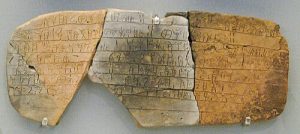
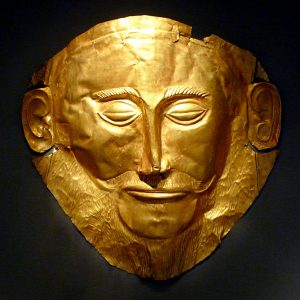
In the 13th century some unknown threat prompted the Mycenaean kings to fortify the palaces at Mycenae and elsewhere with stone walls. By 1200 BCE most of the fortified sites had been destroyed. Afterward, only a few people continued to live in the old towns. It appears likely that Mycenaean Greece suffered from a combination of internal weakness and foreign invasion similar to that experienced by most of the eastern Mediterranean around 1250-1100, the invasion of the Sea Peoples.
The Collapse of the Bronze Age
The Bronze Age at its height witnessed several large empires and peoples in regular contact with one another through both trade and war. The pharaohs of the New Kingdom corresponded with the kings and queens of the Hittite Empire and the rulers of the Kassites and Assyrians; it was normal for rulers to refer to one another as “brother” or “sister.” Each empire warred with its rivals at times, but it also worked with them to protect trade routes. Certain Mesopotamian languages, especially Akkadian, became international languages of diplomacy, allowing travelers and merchants to communicate wherever they went. Even the warlike and relatively unsophisticated Mycenaeans played a role on the periphery of this ongoing network of exchange.
That said, most of the states involved in this network fell into ruin between 1200 – 1100 BCE. The great empires collapsed, a collapse that it took over 100 years to recover from, with new empires arising in the aftermath. There is still no definitive explanation for why this collapse occurred, not least because the states that had been keeping records stopped doing so as their bureaucracies disintegrated. The surviving evidence seems to indicate that some combination of events – some caused by humans and some environmental – probably combined to spell the end to the Bronze Age.
Around 1050 BCE, two of the victims of the collapse, the New Kingdom of Egypt and the Hittite Empire, left clear indications in their records that drought had undermined their grain stores and their social stability. In recent years archaeologists have presented strong scientific evidence that the climate of the entire region became warmer and more arid, supporting the idea of a series of debilitating droughts. Even the greatest of the Bronze Age empires existed in a state of relative precarity, relying on regular harvests in order to not just feed their population, but sustain the governments, armies, and building projects of their states as a whole. Thus, environmental disaster could have played a key role in undermining the political stability of whole regions at the time.
Even earlier, starting in 1207 BCE, there are indications that a series of invasions swept through the entire eastern Mediterranean region. The New Kingdom of Egypt survived the invasion of the “sea people,” some of whom historians are now certain went on to settle in Canaan (they are remembered in the Hebrew Bible as the Philistines against whom the early Hebrews struggled), but the state was badly weakened in the process. In the following decades, other groups that remain impossible to identify precisely appear to have sacked the Mycenaean palace complexes and various cities across the Near East. While Assyria in northern Mesopotamia survived the collapse, it lost its territories in the south to Elan, a warlike kingdom based in present-day southern Iran.
The identity of the foreign invaders is not clear from the scant surviving record. One distinct possibility is that the “bandits” (synonymous in many cases with “barbarians” in ancient accounts) blamed for destabilizing the region might have been a combination of foreign invaders and peasants displaced by drought and social chaos who joined the invasions out of desperation. It is thus easy to imagine a confluence of environmental disaster, foreign invasion, and peasant rebellion ultimately destroying the Bronze Age states. What is clear is that the invasions took place over the course of decades – from roughly 1180 to 1130 BCE – and that they must have played a major role in the collapse of the Bronze Age political and economic system.
For roughly 100 years, from 1200 BCE to 1100 BCE, the networks of trade and diplomacy considered above were either disrupted or destroyed completely. Egypt recovered and new dynasties of pharaohs were sometimes able to recapture some of the glory of the past Egyptian kingdoms in their building projects and the power of their armies, but in the long run Egypt proved vulnerable to foreign invasion from that point on. Mycenaean civilization collapsed utterly, leading to a Greek “dark age” that lasted some three centuries. The Hittite Empire never recovered in Anatolia, while in Mesopotamia the most noteworthy survivor of the collapse – the Assyrian state – went on to become the greatest power the region had yet seen.
The decline of the Bronze Age led to the beginning of the Iron Age. Bronze was dependent on functioning trade networks: tin was only available in large quantities from mines in what is today Afghanistan, so the collapse of long-distance trade made bronze impossible to manufacture. Iron, however, is a useful metal by itself without the need of alloys (although early forms of steel – iron alloyed with carbon, which is readily available everywhere – were around almost from the start of the Iron Age itself). Without copper and tin available, some innovative smiths figured out that it was possible, through a complicated process of forging, to create iron implements that were hard and durable. Iron was available in various places throughout the Middle East and Mediterranean regions, so it did not require long-distance trade as bronze had. The Iron Age thus began around 1100 BCE, right as the Bronze Age ended.
One cautionary note in discussing this shift: iron was very difficult to work with compared to bronze, and its use spread slowly. For example, while iron use became increasingly common starting in about 1100 BCE, the later Egyptian kingdoms did not use large amounts of iron tools until the seventh century BCE, a full five centuries after the Iron Age itself began. Likewise, it took a long time for “weaponized” iron to be available, since making iron weapons and armor that were hard enough to endure battle conditions took a long time. Once trade networks recovered, bronze weapons were still the norm in societies that used iron tools in other ways for many centuries.
Outside of Greece, which suffered its long “dark age” following the collapse of the Bronze Age, a number of prosperous societies and states emerged relatively quickly at the start of the Iron Age. They re-established trade routes and initiated a new phase of Middle Eastern politics that eventually led to the largest empires the world had yet seen.
Iron Age Cultures and States
The Phoenicians
The region of Canaan, which corresponds with modern Palestine, Israel, and Lebanon, had long been a site of prosperity and innovation. Merchants from Canaan traded throughout the Middle East, its craftsmen were renowned for their work, and it was even a group of Canaanites – the Hyksos – who briefly ruled Egypt during the Second Intermediate Period. Along with their neighbors the Hebrews, the most significant of the ancient Canaanites were the Phoenicians, whose cities (politically independent but united in culture and language) were centered in present-day Lebanon.
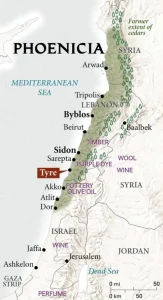
Phoenician is a term coined from the Greek word phoinix, which Greeks likely used to refer to the color of the purple dyes produced by the Phoenicians. The Phoenicians were not a particularly warlike people. Instead, they are remembered for being travelers and merchants, particularly by sea. They traveled farther than any other ancient people; sometime around 600 BCE, according to the Greek historian Herodotus, a Phoenician expedition even sailed around Africa over the course of three years (if that actually happened, it was an achievement that would not be accomplished again for almost 2,000 years). The Phoenicians established colonies all over the shores of the Mediterranean, where they provided anchors in a new international trade network that eventually replaced the one destroyed with the fall of the Bronze Age. Likewise, Phoenician cities served as the crossroads of trade for goods that originated as far away as England (metals were mined in England and shipped all the way to the Near East via overland routes). The most prominent Phoenician city was Carthage in North Africa, which centuries later became the great rival of the Roman Republic.
Around 800 BCE, Phoenicians began trading across the Mediterranean, primarily with Greeks and other groups in the Mediterranean. Some of the most prominent resources they traded were lumber from Lebanon and dyes created from the shells of sea snails (murex). One of the most prominent Phoenician trading colonies was Carthage, which was a stepping stone for Phoenicians trading for tin as far east as the Iberian peninsula. Carthaginians maintained linguistic and ethnic ties to the Phoenicians until the fall of Carthage in the Third Punic War circa 146 CE. The Phoenicians produced other goods, such as carved ivory, metalwork, and textiles. Sidon, a major Phoenician city, was renowned throughout the Mediterranean and its goods and wares were mentioned in Homer’s Illiad in two different passages.
Phoenician trade was not, however, the most important legacy of their society. Instead, of their various accomplishments, none was to have a more lasting influence than that of their writing system. As early as 1300 BCE, building on the work of earlier Canaanites, the Phoenicians developed a syllabic alphabet that formed the basis of Greek and Roman writing much later. A syllabic alphabet has characters that represent sounds, rather than characters that represent things or concepts. These alphabets are much smaller and less complex than symbolic ones. It is possible for a non-specialist to learn to read and write using a syllabic alphabet much more quickly than using a symbolic one (like Egyptian hieroglyphics or Chinese characters). Thus, in societies like that of the Phoenicians, there was no need for a scribal class, since even normal merchants could become literate. Ultimately, the Greeks and then the Romans adopted Phoenician writing, and the alphabets used in most European languages in the present is a direct descendant of the Phoenician one as a result. To this day, the English word “phonetic,” meaning the correspondence of symbols and sounds, is directly related to the word “Phoenician.”
The Phoenician mastery of sailing and the use of the syllabic alphabet were both boons to trade. Another was a practice – the use of currency – originating in the remnants of the Hittite lands. Lydia, a kingdom in western Anatolia, controlled significant sources of gold (giving rise to the Greek legend of King Midas, who turned everything he touched into gold). In roughly 650 BCE, the Lydians came up with the idea of using lumps of gold and silver that had a standard weight. Soon, they formalized the system by stamping marks into the lumps to create the first true (albeit crude) coins, called staters. Currency revolutionized ancient economics, greatly increasing the ability of merchants to travel far afield and buy foreign goods, because they no longer had to travel with huge amounts of goods with them to trade. It also made tax collection more efficient, strengthening ancient kingdoms and empires.
The Assyrians
While the Phoenicians played a major role in jumpstarting long-distance trade after the collapse of the Bronze Age, they did not create a strong united state. Such a state emerged farther east, however: alone of the major states of the Bronze Age, the Assyrian kingdom in northern Mesopotamia survived. Around 1200 BCE the Assyrian state collapsed during the larger era of international crisis, but they held onto a small homeland of about 5,000 square miles, roughly the size of Connecticut. The survivors emerged with an aggressive, expansionist ideology. Assyria’s greatest successes came in the 8th and 7th centuries. One by one Babylonia, Syria, the kingdom of Israel, and even much of Egypt fell to the Assyrians.
Assyria became the first state to rule the two great river valleys of the ancient Near East, the Nile and the Tigris-Euphrates. Probably because of their extreme focus on militarism, the Assyrians were able to hold on to their core cities while the states around them collapsed. During the Iron Age, the Assyrians became the most powerful empire the world had ever seen. The Assyrians were the first empire in world history to systematically conquer almost all of their neighbors using a powerful standing army and go on to control the conquered territory for hundreds of years. The key to Assyria’s success was its army-100,000 to 200,000 men strong-which made an unforgettable impression on observers and foes. The Israelite prophet Isaiah of Jerusalem said of Assyrian soldiers: “Their arrows are sharpened, and all their bows bent, their horses’ hoofs are like flint, their chariot wheels like the whirlwind. Their growling is like that of a lion.” In addition to this description, he might have added that Assyrian spearmen, archers, and cavalrymen were equipped with weapons and armor of iron. They represented the pinnacle of military power and bureaucratic organization of all of the civilizations considered thus far.
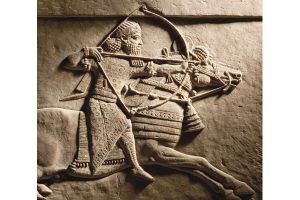
The Assyrians were shaped by their environment. Their region in northern Mesopotamia, Ashur, has no natural borders, and thus they needed a strong military to survive; they were constantly forced to fight other civilized peoples from the west and south, and barbarians from the north. The Assyrians held that their patron god, a god of war also called Ashur, demanded the subservience of other peoples and their respective gods. Thus, their conquests were justified by their religious beliefs as well as a straightforward desire for dominance. Eventually, they dispatched annual military expeditions and organized conscription, fielding large standing armies of native Assyrian soldiers who marched out every year to conquer more territory.
The period of political breakdown in Mesopotamia following the collapse of the Bronze Age ended in about 880 BCE when the Assyrian king Ashurnasirpal II began a series of wars to conquer Mesopotamia and Canaan. Over the next century, the (Neo-)Assyrians became the mightiest empire yet seen in the Middle East. They combined terror tactics with various technological and organizational innovations. They would deport whole towns or even small cities when they defied the will of the Assyrian kings, resettling conquered peoples as indentured workers far from their homelands. They tortured and mutilated defeated enemies, even skinning them alive, when faced with any threat of resistance or rebellion. The formerly-independent Phoenician city-states within the Assyrian zone of control surrendered, paid tribute, and deferred to Assyrian officials rather than face their wrath in battle.
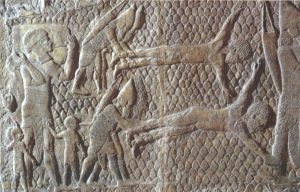
The Assyrians were the most effective military force of the ancient world up to that point. They outfitted their large armies with well-made iron weapons (they appear to be the first major kingdom to manufacture iron weapons in large numbers). They invented a messenger service to maintain lines of communication and control, with messengers on horseback and waystations to replace tired horses, so that they could communicate across their empire. All of their conquered territories were obliged to provide annual tributes of wealth in precious metals and trade goods which funded the state and the military.
The Assyrians introduced two innovations in military technology and organization that were of critical importance: a permanent cavalry, the first of any state in the world, and a large standing army of trained infantry. It took until the middle of the eighth century BCE for selective breeding of horses to produce real “war horses” large enough to carry a heavily armed and armored man into and through an entire battle. The Assyrians adopted horse archery from the barbarians they fought from the north, which along with swords and short lances wielded from horseback made chariots permanently obsolete. The major focus of Assyrian taxation and bureaucracy was to keep the army funded and trained, which allowed them to completely dominate their neighbors for well over a century.
By the time of the reign of Assyrian king Tiglath-Pilezer III (r. 745 – 727 BCE), the Assyrians had pushed their borders to the Mediterranean in the west and to Persia (present-day Iran) in the east. Their conquests culminated in 671 BCE when king Esarhaddon (r. 681 – 668 BCE) invaded Egypt and conquered not only the entire Egyptian kingdom, but northern Nubia as well. This is the first time in history that both of the founding river valleys of ancient civilization, those of the Nile and of Mesopotamia, were under the control of a single political entity.
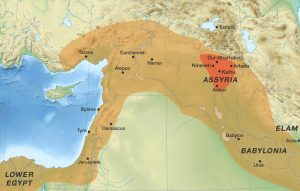
The style of Assyrian rule ensured the hatred of conquered peoples. They demanded constant tribute and taxation and funneled luxury goods back to their main cities. They did not try to set up sustainable economies or assimilate conquered peoples into a shared culture, instead skimming off the top of the entire range of conquered lands. Their style of rule is well known because their kings built huge monuments to themselves in which they boasted about the lands they conquered and the tribute they exacted along the way. The Assyrians also engaged in mass deportations. They uprooted the people of a conquered country, resettled them far away-often in central Assyria itself-and colonized their land with Assyrian loyalists. The so-called Ten Lost Tribes of Israel- the people of the northern Israelite kingdom were conquered by Assyria in 722 BCE. Many of them were transported to Mesopotamia. Assyrian policy was the result of careful calculation. The political goals were to punish rebellion, the economic goals to create a varied labor force. For example, although it is estimated that the Assyrians deported several million people, they deported not whole populations but a carefully chosen cross section of professions. They also deported entire families together, to weaken deportees emotional ties to their former homes.
While their subjects experienced Assyrian rule as militarily-enforced tyranny, Assyrian kings were proud of the cultural and intellectual heritage of Mesopotamia and supported learning and scholarship. The one conquered city in their empire that was allowed a significant degree of autonomy was Babylon, out of respect for its role as a center of Mesopotamian culture. Assyrian scribes collected and copied the learning and literature of the entire Middle East. Sometime after 660 BCE, the king Asshurbanipal ordered the collection of all of the texts of his kingdom, including the ones from conquered lands, and he went on to create a massive library to house them. Parts of this library survived and provide one of the most important sources of information that scholars have on the beliefs, languages, and literature of the ancient Middle East.
The Assyrians finally fell in 609 BCE, overthrown by a series of rebellions. Their control of Egypt lasted barely two generations, brought to an end when the puppet pharaoh put in place by the Assyrians rebelled and drove them from Egypt. Shortly thereafter, a Babylonian king, Nabopolassar, led a rebellion that finally succeeded in sacking Nineveh, the Assyrian capital. The Babylonians were allied with clans of horse-riding warriors in Persia called the Medes, and between them the Assyrian state was destroyed completely. Nabopolassar went on to found the “Neo-Babylonian” empire, which became the most important power in Mesopotamia for the next few generations.
Neo-Babylon
The Neo-Babylonians adopted some of the terror tactics of the Assyrians; they, too, deported conquered enemies as servants and slaves. The Neo-Babylonian king Nebuchadrezaar II (Nebuchadnezzar in the Hebrew bible) conquered the kingdom of Judah (in southern Palestine) in 598 and destroyed Jerusalem in 586. He deported many thousands of Judeans to Babylon, an event remembered by Christians and Jews as the Babylonian Captivity. Most of the rest of Western Asia also fell to Nebuchadnezzar’s’ troops.
The neo-Babylonian rulers tried to re-capture the days of glory of Hammurabi. And they succeeded for decades. Their most enduring accomplishment was rebuilding Babylon on a grand scale. In addition to the city’s numerous temples, shines, and altars, he created the “Hanging Gardens” celebrated by later Greek authors. They described the structure as a large terraced complex that Nebuchadrezzar built for his queen, although it may have been a plant-covered Ziggurat.
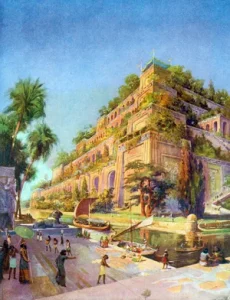
The Neo-Babylonians and Assyrians both made great strides in astronomy. Their primary motive was not scientific, but religious, as they believed that the movement of heavenly bodies influenced human affairs directly. Nonetheless, the study of astrology did lead to advances in scientific observations of the heavens. Assyrian priests produced relatively accurate circular diagrams that showed the positions of the major constellations, stars, and planets over the course of years. By 600 BCE Assyrian and Neo-Babylonian astronomers could predict solstices, equinoxes, and lunar eclipses. Astronomy in Mesopotamia reached its heights in the centuries after 500 BCE. For example, the zodiac, a diagram showing the movement of the sun and planets relative to the constellations, was invented in Persian-ruled Babylon in the 4th century BCE. In the third and second centuries BCE, when Babylonia was under Hellenistic Greek rule, Mesopotamian scientists made impressive advances in mathematical astronomy, composing tables that could be used to calculate movements of earth’s moon and nearby planets. More sophisticated mathematical astronomy would not be produced in the West until the Scientific Revolution of the 16th century CE.
But the Neo-Babylonians and Assyrians also differed in important ways. Most significantly, the Neo-Babylonians were much more focused on trade throughout the region. They built new roads and canals and encouraged long-distance trade throughout their lands. They were often at war with Egypt, which also tried to take advantage of the fall of the Assyrians to seize new land, but even when the two powers were at war Egyptian merchants were still welcome throughout the Neo-Babylonian empire. A combination of flourishing trade and high taxes led to huge wealth for the king and court, and among other things led to the construction of noteworthy works of monumental architecture to decorate their capital. The Babylonians inherited the scientific traditions of ancient Mesopotamia, becoming the greatest astronomers and mathematicians yet seen, able to predict eclipses and keep highly detailed calendars. In the end, however, they were the last of the great ancient Mesopotamian empires that existed independently. Less than 100 years after their successful rebellion against the Assyrians, they were conquered by what became the greatest empire in the ancient world to date: the Persians, described in a later chapter.
The Hebrews/Israelites
Of the Bronze and Iron-Age cultures, one played perhaps the most vital role in the history of Western Civilization: the Hebrews or the Israelites. The Hebrews, a people who first created a kingdom in the ancient land of Canaan, were among the most important cultures of the western world, comparable to the ancient Greeks or Romans. But, unlike the Greeks and Romans, the ancient Hebrews were not known for being scientists or philosophers or conquerors. It was their religion, Judaism, that proved to be of crucial importance in world history, both for its own sake and for being the religious root of Christianity and Islam. Together, these three religions are referred to as the “Religions of the Book,” because they share a set of beliefs first written down in Hebrew holy texts and they all venerate the same God. (Note: it should be emphasized that the approach taken here is that of secular historical scholarship: what is known about the historical origins of Judaism, Christianity, and Islam based on empirical research carried out by historians and archaeologists).
The Hebrews or Israelites argued that human achievement was meaningless, they said that only the power of divinity matters. There was/is only one god, they said; all other gods are false. The one true god had revealed himself not to the awesome, imperialistic Assyrians, but to the less powerful Hebrews, the ancient Jews. They founded Western tradition of religion. The God of ancient Israel eventually gave rise to the God of Christianity and of Islam as well as of modern Judaism. The most significant influence of the Israelites comes from the impact of the book that became their sacred scripture, otherwise known as the Hebrew Bible. This book not only affected Judaism but also Christianity and Islam. Unfortunately, the Bible only gives us hints at the origins and history of the Israelites, most of it being focused on God’s moral plan.
Thus, the history of the ancient Hebrews is a difficult subject. The most important source we have about it is the Hebrew Bible itself, which describes in detail the travails of the Hebrews, their enslavement, battles, triumphs, and accomplishments. The problem with using the Hebrew Bible as a historical source is that it is written in a mythic mode – like the literature of every other Iron Age civilization, many events affecting the Hebrews are explained by direct divine intervention rather than a more prosaic historical approach. Also, the Hebrew Bible was written some 400 – 600 years after the events it describes. Thus, what is known about the ancient Hebrews consists of the stories of the Hebrew Bible supplemented by the archaeological record and the information about the Hebrews available from other historical sources.
According to the Hebrew Bible, the first patriarch (male clan leader) of the Hebrews was Abraham, a man who led the Hebrews away from Mesopotamia in about 1900 BCE. The Hebrews left the Mesopotamian city of Ur and became wandering herders; in fact, the word Hebrew originally meant “wanderer” or “nomad.” Abraham had a son, Isaac, and Isaac had a son, Jacob, collectively known as the Patriarchs in the Hebrew Bible. The Mesopotamian origins of the Hebrews are unclear from sources outside of the Hebrew Bible itself; archaeological evidence indicates that the Hebrews may have actually been from the Levant, with trade contact with the Mesopotamians, rather than coming from Mesopotamia.
According to Jewish belief, by far the most important thing Abraham did was agree to the Covenant, the promise made between the God Yahweh (the “name” of God is derived from the Hebrew characters for the phrase “I am who I am,” the enigmatic response of God when asked for His name by the prophet Moses) and the Hebrews. The Covenant stated that in return for their devotion and worship, and the circumcision of all Hebrew males, the Hebrews would receive from Yahweh a “land of milk and honey,” a place of peace and prosperity of their own for all time.
Then, in about 1600 BCE, the Hebrews went to Egypt to escape famine and were welcomed by the Hyksos dynasty, if they were not the Hyksos to begin with, (during the Second Intermediate Period of ancient Egypt). The Hyksos were fellow Canaanites, after all, and they appear to have encouraged the Hebrews to stay. According to the Hebrew Bible, with the rise of the New Kingdom and expulsion of the Hyksos the Hebrews were enslaved, with their leader Moses leading them away sometime around 1300 – 1200 BCE. There is little archaeological or Egyptian textual evidence to support the story of the complete enslavement of the Hebrews, besides references in Egyptian sources to Canaanite laborers. A pharaoh, Merneptah, makes a passing reference to a people he simply called “Israel” as living in Canaan in 1207 BCE, which is the strongest evidence of the Hebrews’ presence in Canaan in the late Bronze Age.
According to the Hebrew Bible, Moses was not only responsible for leading the Hebrews from Egypt, but for modifying the Covenant. In addition to the exclusive worship of Yahweh and the circumcision of all male Hebrews, the Covenant was amended by Yahweh to include specific rules of behavior: the Hebrews had to abide by the 10 Commandments in order for Yahweh to guarantee their prosperity in the promised land. Having agreed to the Commandments, the Hebrews then arrived in the region that was to become their first kingdom, Israel.
As noted above, the tales present in the Hebrew Bible cannot generally be verified with empirical evidence. They also bear the imprint of earlier traditions: many stories in the Hebrew Bible are taken from earlier Mesopotamian legends. The story of Moses is very close to the account of Sargon the Great’s rise from obscurity in Akkadian tradition, and the flood legend (described in the Bible’s first book, Genesis) is taken directly from the Epic of Gilgamesh, although the motivation of the Mesopotamian gods versus that of Yahweh in those two stories is very different: the Mesopotamian gods are cruel and capricious, while the flood of Yahweh is sent as a punishment for the sins of humankind.
Archaeological evidence has established that the Hebrews definitely started settling in Canaan by about 1200 BCE. The Egyptian record from 1207 BCE noted above consists of the pharaoh boasting about his conquests in Canaan, including Israel. The story of Moses leading the Hebrews out of slavery in Egypt could also have been based on the events associated with the collapse of the Bronze Age, the great century or so of upheaval in which nomadic raiders joined forces with oppressed peasants and slaves to topple the great empires of the Bronze Age. Some of those people, probably Canaanites who had been subjects of the pharaohs, did seize freedom, and they could well have included the Hebrews.
The Kings and Kingdoms
While the early Hebrews were communalists, meaning they shared most goods in common within their clans (referred to as the twelve “tribes” in the Hebrew Bible), conflicts with the Philistines, another Canaanite people on the coast, led them to appoint a king, Saul, in about 1020 BCE. The Philistines were likely one of the groups of “Sea Peoples” who attacked the New Kingdom of Egypt. The Philistines were a small but powerful kingdom. They were armed with iron and they fought the Hebrews to a standstill initially – at one point they captured the Ark of the Covenant, containing the stone tablets on which the Ten Commandments were written. Under the leadership of their kings, however, the Hebrews pushed back the Philistines and eventually defeated them completely.
Saul’s successor was David, one of his former lieutenants, and David’s was his son Solomon. The Hebrew kings founded a capital at Jerusalem, which had been a Philistine town. The kings created a professional army, a caste of scribes, and a bureaucracy. All of this being noted, the kingdom itself was not particularly large or powerful; Jerusalem at the time was a hill town of about 5,000 people. Israel emerged as one of the many smaller kingdoms surrounded by powerful neighbors, engaging in trade and waging small-scale wars depending on the circumstances.
Solomon was an effective ruler, forming trade relationships with nearby kingdoms and overseeing the growing wealth of Israel. He also lived in a manner consistent with other Iron Age kings, with many wives and a whole harem of concubines as well. Likewise, he taxed both trade passing through the Hebrew kingdom and his own subjects. His demands for free labor from the Hebrew people amounted to one day in every three spent working on palaces and royal building projects – an enormous amount from a contemporary perspective, but one that was at least comparable to the redistributive economies of nearby kingdoms. Thus, while his subjects came to resent aspects of his rule, neither was it markedly more exploitative than the norm in the region as a whole.
The most important building project under Solomon was the great Temple of Jerusalem, the center of the Yahwist religion. There, a class of priests carried out rituals and worship of Yahweh. Members of the religion believed that God’s attention was centered on the Temple. Likewise, the rituals were similar to those practiced among various Middle Eastern religions, focusing on the sacrifice and burning of animals as offerings to God. David and Solomon supported the priesthood, and there was thus a direct link between the growing Yahwist faith and the political structure of Israel.
A Peak inside of Solomon’s Temple….
The northern kingdom of Israel was larger, richer, and more cosmopolitan. Israel’s capital was the city of Samaria, and its people became known as Samaritans; they appear to have interacted with neighboring peoples frequently and many of them remained polytheists (people who worship more than one god) despite the growing movement to focus worship exclusively on Yahweh. The southern kingdom of Judah was poorer, smaller, and more conservative; it was in Judah that the Prophetic Movement (see below) came into being. It is from Judah that we get the word Jew: the Jews were the people of Judah.
With its riches, Israel was more attractive to invaders. When the Assyrian Empire expanded beyond Mesopotamia, it first conquered Israel, then eventually destroyed it outright when the Israelites rose up against them (this occurred in 722 BCE). The inhabitants of Israel either fled to Judah or were absorbed into the Assyrian Empire, losing their cultural identity in the process. This tragedy was later remembered as the origin of the “lost tribes” of Israel – Hebrews who lost their identity and their religion because of the Assyrian enslavement. Judah was overrun by the Assyrians, but Jerusalem withstood a siege long enough to convince the Assyrians to accept bribes to leave, and instead became a satellite kingdom dominated by the Assyrians but still ruled by a Hebrew king. (Judah was saved in part due to a plague that struck the Assyrian army, but it still ended up a tributary of the Assyrians, paying annual tributes and answering to an Assyrian official.)
In Judah, there were two prevailing patterns: vassalage and rebellion. Judah was simply too small to avoid paying tribute to various neighboring powers, but its people were proud and defensive of their independence, so every generation or so there were uprisings. The worst case was in 586 BCE, when the Jews rose up against the Neo-Babylonian Empire that succeeded the Assyrians. The Babylonians burned Jerusalem, along with Solomon’s Temple, to the ground, and they enslaved tens of thousands of Jews. The Jews were deported to Babylon, just as the Israelites had been deported to Assyrian territory about 150 years earlier – this event is referred to as the “Babylonian Captivity” of the Jews.
Two generations later, when the Neo-Babylonian empire itself fell to the Persians, the Persian emperor Cyrus the Great allowed all of the enslaved people of the Babylonians to return to their homelands, so the Babylonian Captivity came to an end and the Jews returned to Judah, where they rebuilt the Temple. That being noted, what is referred to as the Jewish “diaspora,” meaning the geographical dispersion of the Jews, really began in 538 BCE, because many Jews chose to remain in Babylon and, soon, other cities in the Persian Empire. Since they continued to practice Judaism and carry on Jewish traditions, the notion of a people scattered across different lands but still united by culture and religion came into being.
After being freed by Cyrus, the Jews were still part of the Persian Empire, ruled by a Persian governor (called a “satrap”). For most of the rest of their history, the Jews were able to maintain their distinct cultural identity and their religion, but rarely their political independence. The Jews went from being ruled by the Persians to the Greeks to the Romans (although they did occasionally seize independence for a time), and were then eventually scattered across the Roman Empire. The real hammer-blow of the Diaspora was in the 130s CE, when the Romans destroyed much of Jerusalem and forced almost all of the Jews into exile – the word diaspora itself means “scattering,” and with the destruction of the Jewish kingdom by Rome there would be no Jewish state again until the foundation of the modern nation of Israel in 1948 CE.
The Yahwist Religion and Judaism
The Hebrew Bible claims that the Jews as a people worshipped Yahweh exclusively from the time of the Covenant, albeit with the worship of “false” gods from neighboring lands sometimes undermining their unity (and inviting divine retribution on the part of Yahweh for those transgressions). There is no historical or archaeological evidence that suggests a single unified religion in Israel or Judah during the period of the united Hebrew monarchy or post-Solomon split between Israel and Judah, however (the Hebrew Bible itself was written down centuries later). A more likely scenario is that the Hebrews, like every other culture in the ancient world, worshipped a variety of deities, with Yahweh in a place of particular importance and centrality. A comparable case would be that of the Assyrians, who emphasized the worship of Ashur but who acknowledged the existence of other gods (including Yahweh).
As the Hebrews became more powerful, however, their religion changed dramatically. A tradition of prophets, later remembered as the Prophetic Movement, arose among certain people who sought to represent the poorer and more beleaguered members of the community, calling for a return to the more communal and egalitarian society of the past. The Prophetic Movement claimed that the Hebrews should worship Yahweh exclusively, and that Yahweh had a special relationship with the Hebrews that set Him apart as a God and them apart as a people. The Prophetic Movement lasted from the period before the Assyrian invasion of Israel through the Babylonian Captivity of the Jews, from about 750 BCE – 550 BCE.
This new set of beliefs, regarding the special relationship of a single God to the Hebrews, is referred to historically as the Yahwist religion. It was not yet “Judaism,” since it did not yet disavow the belief that other gods might exist, nor did it include all of the rituals and traditions associated with later Judaism. Initially, most of the Hebrews continued to at least acknowledge the existence of other gods – this phenomenon is called henotheism, the term for the worship of only one god in the context of believing in the existence of more than one god (i.e. many gods exist, but we only worship one of them). Over time, this changed into true monotheism: the belief that there is only one god, and that all other “gods” are illusory.
The Prophetic Movement attacked both polytheism and the Yahwist establishment centered on the Temple of Jerusalem (they blamed the latter for ignoring the plight of the common people and the poor). The prophets were hostile to both the political power structure and to deviation from the exclusive worship of Yahweh. The prophets were also responsible for enunciating the idea that Yahweh was the only god, in part in reaction to the demands of Assyria that all subjects acknowledge the Assyrian god Ashur as the supreme god. In other words, the claim of the Prophetic Movement was not only that Yahweh was superior to Ashur, but that Ashur was not really a god in the first place.
This is, so far as historians know, the first instance in world history in which the idea of a single all-powerful deity emerged among any people, anywhere (although some scholars consider Akhenaten’s attempted religious revolution in Egypt a quasi-monotheism). Up to this point, all religions held that there were many gods or spirits and that they had some kind of direct, concrete connections to specific areas. Likewise, the gods in most religions were largely indifferent to the actions of individuals so long as the proper prayers were recited and rituals performed. Ethical conduct did not have much influence on the gods (“ethical conduct” itself, of course, differing greatly from culture to culture), what mattered was that the gods were adequately appeased.
In contrast, early Judaism developed the belief that Yahweh was deeply invested in the actions of His chosen people both as a group and as individuals, regardless of their social station. There are various stories in which Yahweh judged people, even kings like David and Solomon, making it clear that all people were known to Yahweh and no one could escape His judgment. The key difference between this belief and the idea of divine anger in other ancient religions was that Yahweh only punished those who deserved it. He was not capricious and cruel like the Mesopotamian gods, for instance, nor flighty and given to bickering like the Greek gods.
The early vision of Yahweh present in the Yahwist faith was of a powerful but not all-powerful being whose authority and power was focused on the Hebrew people and the territory of the Hebrew kingdom only. In other words, the priests of Yahweh did not claim that he ruled over all people, everywhere, only that he was the God of the Hebrews and their land. That started to change when the Assyrians destroyed the northern kingdom of Israel in 722 BCE. Many of the Hebrews regarded this disaster as proof of the corruption of the rich and powerful and the righteousness of the Prophetic Movement. Even though the loss of Israel was an obvious blow against the Hebrews as a people, the worship of Yahweh as the exclusive god of the Hebrews gained considerable support in Judah. Likewise, as the exclusive worship of Yahweh grew in importance among the Jews (now sundered from the other Hebrews, who had been enslaved), the concept of Yahweh’s omnipotence and omnipresence grew as well.
The most important reforms of Hebrew religion occurred in the seventh century BCE. A Judean king, Josiah, insisted on the imposition of strict monotheism and the compilation of the first books of the Hebrew Bible, the Torah, in 621 BCE. In the process, the Yahwist priesthood added the book of Deuteronomy to older sacred writings (the priests claimed to have discovered Deuteronomy, but almost all historians of ancient religion believe that it was simply written at the time). When many Jews left the religion after Josiah’s death, the prophet Jeremiah warned them that disaster would ensue, and when the Neo-Babylonians conquered Judah in 586 BCE, it seemed to validate his warning. Likewise, during the Babylonian Captivity, the prophet Ezekiel predicted the liberation of the Hebrews if they stuck to their faith, and they were indeed freed thanks to Cyrus (who admired older cultures like the Hebrews, since the Persians were originally semi-nomadic).
The sacred writings compiled during these events were all in the mode of the new monotheism. In these writings, Yahweh had always been there as the exclusive god of the Hebrew people and had promised them a land of abundance and peace (i.e. Israel) in return for their exclusive worship of Him. In these histories, the various defeats of the Hebrew people were explained by corruption from within, often the result of Hebrews straying from the Covenant and worshiping other gods.
These reforms were complete when the Neo-Babylonians conquered Judah in 586 BCE and enslaved tens of thousands of the Hebrews. The impact of this event was enormous, because it led to the belief that Yahweh could not be bound to a single place. He was no longer just the god of a single people in a single land, worshiped at a single temple, but instead became a boundless God, omnipotent and omnipresent. The special relationship between Him and the Hebrews remained, as did the promise of a kingdom of peace, but the Hebrews now held that He was available to them wherever they went and no matter what happened to them.
In Babylon itself, the thousands of Hebrews in exile not only arrived at this idea, but developed the strict set of religious customs, of marriage laws and ceremonies, of dietary laws (i.e. keeping a kosher diet), and the duty of all Hebrew men to study the sacred books, all in order to preserve their identity. Once the Torah was compiled as a single sacred text by the prophet Ezra, one of the official duties of the scholarly leaders of the Jewish community, the rabbis, was to carefully re-copy it, character by character, ensuring that it would stay the same no matter where the Jews went. The result was a “mobile tradition” of Judaism in which the Jews could travel anywhere and take their religion with them. This would become important in the future, when they were forcibly taken from Judah by the Romans and scattered across Europe and North Africa. The ability of the Jews to bring their religious tradition with them would allow them to survive as a distinct people despite ongoing persecution in the absence of a stable homeland.
Another important aspect of Judaism was its egalitarian ethical system. The radical element of Jewish religion, as well as the Jewish legal system that arose from it, the Talmud, was the idea that all Jews were equal before God, rather than certain among them having a closer relationship to God. This is the first time a truly egalitarian element enters into ethics; no other people had proposed the idea of the essential equality of all human beings (although some aspects of Egyptian religion came close). Of all the legacies of Judaism, this may be the most important, although it would take until the modern era for political movements to take up the idea of essential equality and translate them into a concrete social, legal, and political system.
What all of the cultures considered in this chapter have in common is that they were more dynamic and, in the case of the empires, more powerful than earlier Mesopotamian (and even Egyptian) states. In a sense, the empires of the Bronze Age and, especially, the Iron Age represented different experiments in how to build and maintain larger economic systems and political units than had been possible earlier. The other major change is that it now becomes possible to discuss and examine the interactions between the various kingdoms and empires, not just what happened with them internally, since the entire region from Greece to Mesopotamia was now in sustained contact through trade, warfare, and diplomacy.
Likewise, some of the ideas and beliefs that originated in the Bronze and Iron Ages – most obviously Judaism – would go on to play a profound role in shaping the subsequent history of not just Western Civilization, but much of world history. Monotheism and the concept of the essential spiritual equality of human beings began as beliefs among a tiny minority of people in the ancient world, but they would go on to become enormously influential in the long run.

